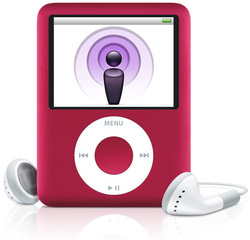| valentino_marlett.m4a |

Of all the different technologies mentioned throughout these blogs, Podcasts and Skype appear to be the best.
Podcasts can be done in both audio and video format. To create a Podcast on a Mac, simply open up Garage Band and hit record. You can also add pictures, chapters, details, and other cool things. However, if you're not one of the Apple people (twice the price, half the power), then follow this link. It tells you how to create your own free audio Podcast on Windows based PCs. The Podcast is a great tool for the classroom. One of the most noticeable uses is to record lectures. This way, both the audio file and PowerPoints can be put online for absent students. Podcasts can also be used by teachers who want to give their students supplementary material.
Another useful tool in the classroom is Skype. Skype is an online telephone network that allows users to video chat for free. As with the Podcasts, Skype can be a great tool for absent students. The students can Skype in during class time so they don't become too far behind. This can also be used by students to collaborate on projects when they are not physically in the same place. Lastly, Skype can be a great tool for connecting my classroom to the world. I can have historians, students from different countries, and countless other professionals Skype into my classroom and help the learning environment flourish.
This technology (and others) can be used to supplement teaching strategies. One very useful teaching strategy is Inquiry Based Learning. Through inquiry based learning, students ask the questions they want answered. The students then search for the answers to their own questions. As with other student-centered approaches to teaching, this is thought to be incredibly useful because the students are learning according to their own interests. As such, these types of activities can help spur lifelong learners. However, one downside to Inquiry Based Learning is time constraints. As with all student-centered teaching models, a considerable amount of classroom time must be dedicated to the assignment.
Podcasts can be done in both audio and video format. To create a Podcast on a Mac, simply open up Garage Band and hit record. You can also add pictures, chapters, details, and other cool things. However, if you're not one of the Apple people (twice the price, half the power), then follow this link. It tells you how to create your own free audio Podcast on Windows based PCs. The Podcast is a great tool for the classroom. One of the most noticeable uses is to record lectures. This way, both the audio file and PowerPoints can be put online for absent students. Podcasts can also be used by teachers who want to give their students supplementary material.
Another useful tool in the classroom is Skype. Skype is an online telephone network that allows users to video chat for free. As with the Podcasts, Skype can be a great tool for absent students. The students can Skype in during class time so they don't become too far behind. This can also be used by students to collaborate on projects when they are not physically in the same place. Lastly, Skype can be a great tool for connecting my classroom to the world. I can have historians, students from different countries, and countless other professionals Skype into my classroom and help the learning environment flourish.
This technology (and others) can be used to supplement teaching strategies. One very useful teaching strategy is Inquiry Based Learning. Through inquiry based learning, students ask the questions they want answered. The students then search for the answers to their own questions. As with other student-centered approaches to teaching, this is thought to be incredibly useful because the students are learning according to their own interests. As such, these types of activities can help spur lifelong learners. However, one downside to Inquiry Based Learning is time constraints. As with all student-centered teaching models, a considerable amount of classroom time must be dedicated to the assignment.